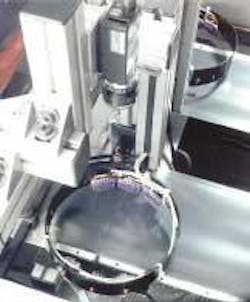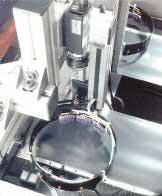Automated inspection speeds changeovers
Elementary-school students and CEOs are similar in one way: they rarely give much thought to the plastic covers that hold their book reports and business proposals. To the contrary, Widmann Welding Machines (Schlierbach, Germany) thinks about little else. Its folders are made from a single roll of plastic material. The material is folded and heat-welded along longitudinal and transverse seams; slits are cut in the plastic to allow paper to be inserted; and, finally, logos are applied. Defects at any of these steps result in defective product and reduced production yields.
In addition to having production speeds of 450 folders per minute and a number of inspections points, the requirement for flexible manufacturing lines has complicated the ability of Widmann to perform 100% quality inspection. Short runs and quick product changeover means that an automated inspection system also must quickly adjust to a new inspection task while meeting the inspection speed requirements.
Widmann relies on Leuze Mayser Electronic (Cambs, UK; www.leuzemayser.co.uk) and its proCHECK inspection system for a cost-effective solution. The proCHECK can handle up to 12 cameras for multiple inspection tasks using a single PC host.
Hooked up to a Widmann PLC controlling a pair of SH-K3e folder machines, the proCHECK is configured with a pair of Panasonic (Secaucus, NJ, USA; www.panasonic.com) GP-MF802 652 × 494-pixel progressive-scan CCD cameras—one for each folder machine—each with a Pentax (Hamburg, Germany; www.pentax.com) 1614M compact lens. Using 12-pin dual-channel output to a pair of Leuze Mayser frame grabbers in the PC host, each camera can output asynchronous frames at up to 60 Hz, far in excess of the inspection speed of 450 pieces per minute.
The asynchronous operation allows proCHECK to operate on two separate production lines simultaneously, using one PC host, while the cameras' square pixels help proCHECK make reliable 2-D distance measurements, according to Leuze Mayser Electronic vision-system designer Jurgen-Ralf Weber. A custom LED strobe from Leuze Mayser provides high contrast for the high-speed inspection system.
The images are fed into the frame grabber for processing. Using several thresholding, edge-detection, and caliper algorithms, it measures the lengths of the seams and slit in the folder, as well as the relative position between seams and quality of the stamped logo. "We use our own frame grabber because it supports asynchronous acquisition and internal picture processing," Weber explains. By performing most of the image processing at the frame grabber, proCHECK can expand the number of inspection stations by simply adding a camera and frame grabber rather than another PC host.
After inspection, proCHECK stores the results and images of 'failed' inspections on the PC internal hard drive and sends the results to the PLC. Operational parameters are set and changeovers managed through the system menu-driven user interface that resides in the PC RAM. The system sends the operator set results to the PLC supervising the SH-K3e machines using an INTERBUS-S board in the PC.

